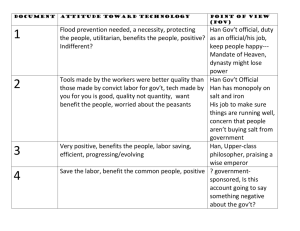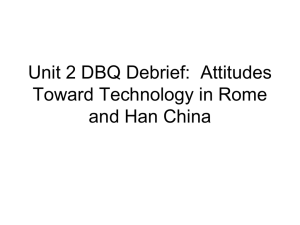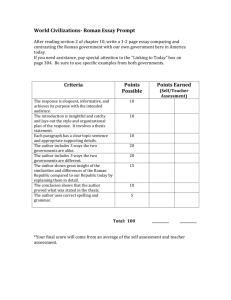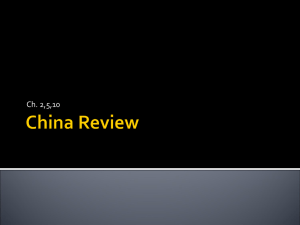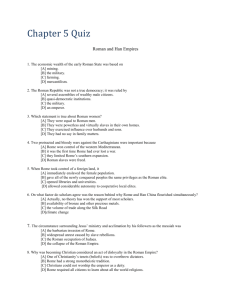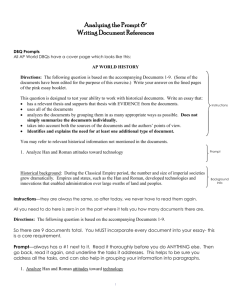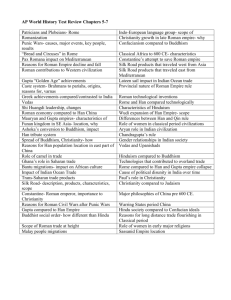Document Based Question (DBQ)
advertisement
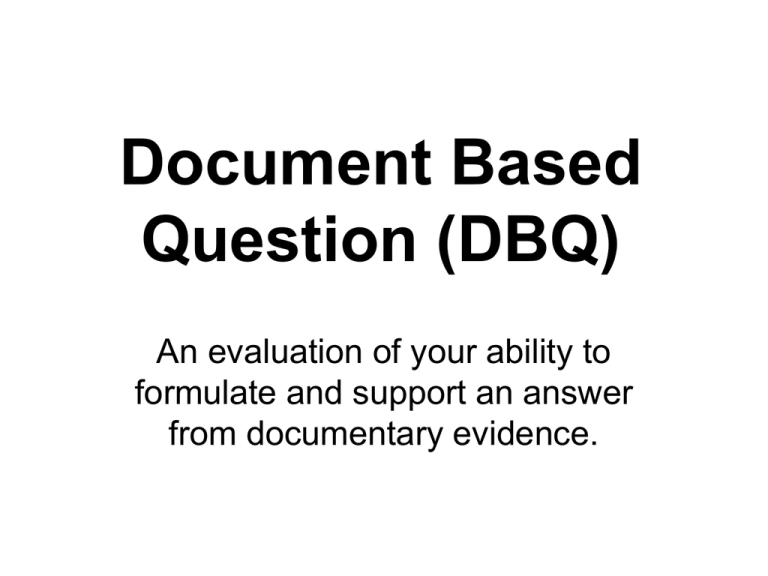
Document Based Question (DBQ) An evaluation of your ability to formulate and support an answer from documentary evidence. DBQ Essay – What is it? • There is no single correct answer, various approaches and responses are possible depending on the students’ ability to understand and analyze the documents. • Read and analyze the documents, then respond to the essay question based on the documentary evidence. • Group documents based on content and different points of view. • Write a clear thesis that addresses the essay prompt. More things to know . . . • Use all the documents to illustrate essay points • Use parenthetical documentation (Doc 1) • Do not just summarize/paraphrase the documents • All documents are relevant and should be used. • 4 – 10 documents The Rubric – How to Get Those Points! Basic Core • Thesis- 1 point – Has a clear thesis statement in the first paragraph that addresses all parts of the question – May be one or multiple sentences • Addresses all the Documents/Understands the Documents 1 point – Address all documents – Demonstrate understanding of the document by using the documents to address the essay questions – Listing the documents separately or as a group DOES NOT demonstrate understanding – Quoting a document does not demonstrate understanding • Supports thesis with appropriate evidence from all or all but one document 2 points – Evidence from all documents that address the question • Analyzes point of view in at least three documents 1 point – Explain why an author has a particular point of view, or what informs the author’s point of view – Explain tone, intended audience, or intended outcome • Analyzes documents by grouping them in three ways 1point – Explicitly addresses the question by grouping documents based on analysis of content and/or points of view – May juxtapose documents • Identifies and explains the need for additional documents 1 point – Must identify an appropriate additional document or source – Explain how the document or source will contribute to the analysis – What points of view are missing and why are they needed • Expanded Core 2 points – Only possible after achieving Basic Core (7 points) – Great thesis, great analysis, pov in all documents, additional groupings, subgroupings, outside historical content, clear and comprehensive conclusion World History Section II Part A Suggested writing time – 40 minutes Percent of Section II score – 33 1/3 Directions: the following question is based on the accompanying Documents 1-8. The documents have been edited for the purpose of this exercise. Write your answer on the lined pages of the Section II free-response booklet. This question is designed to test your ability to work with and understand historical documents. Write an essay that: •Has a relevant thesis and supports that thesis with evidence from the documents •Uses all of the documents •Analyzes the documents by grouping them in as many ways as possible. Does not simply summarize the documents individually •Takes into account the sources of the documents and analyzes the authors’ point of view •Explains the need for at least one additional type of document 1. Using the documents, analyze Han and Roman attitudes toward technology. Identify one additional type of document and explain briefly how it would help your analysis. • Attitude – how do they feel about technology Document 1 Source: Han government official, writing to local officials concerning flood prevention, early second century BCE I request that you establish water conservation offices in each district and staff them with people who are experienced in the ways of water. There should be one high official and one deputy with just enough workers to meet the need. For the area on both sides of each river select one person as chief hydraulic engineer. Order inspections of the waterways, the walls of the cities and their suburbs, the dikes and rivers, canals and pools, and government buildings and cottages, and supply enough workers to those who are to carry out the repair work in each district. • • • • • Han government official Importance of water, waterways, and other engineering needs Government authority over development of these needs; seen as the proper scope of government to regulate Attitude – technology is essential part of the empire and requires government intervention POV – “Document 1 is a letter from a Han government official concerning flood prevention. Considering his status and the fact that the letter is instructional, it seems reasonable to assume he knows what he’s talking about (credibility) Document 2 Source: Huan Guan, Han government official, Discourses on Salt and Iron, first century BCE In earlier times workers were allowed to do both foundry work and salt-boiling as long as they reported the work and paid a tax. Tools manufactured by individual families to do this work were well-made. Today the iron tools that workers are required to use are produced by the state using convict labor; these tools are often crude and not very functional. In previous times the tools manufactured by workers for their own use and for sale were of excellent quality. Now that the state has monopolized the salt and iron trades, most of the tools provided to the workers are hard and brittle and the responsible government officials are often not available to take complaints. Good implements are hard to come by. Salt and iron are now sold at very high prices by the state and many common people cannot afford to buy either. Some of the poorest peasants now have no choice but to till the soil with wooden plows and cannot afford salt to season their food. • • • • • • Han government official Government created sub-standard tools due to monopoly As a government official, Huan Guan implies that good government should correct the situation Misinterpreted as negative about technology, rather he is negative towards the government’s role Attitude – technology is essential part of peasant production, responsibility of the government to support POV-”This is interesting, because although you’d expect a Han government official to praise the current government and its decisions, he is opposed to what the government is doing and is showing concern for the poor peasants.” Document 3 Source: Huan Tan, upper-class Han philosopher, New Discourses, about 20 ce Fuxi* invented the pestle and mortar. Later on, the pestle and the mortar were cleverly improved in such a way that the whole weight of the body could be used, thus increasing the efficiency ten times. Later, water power was also applied, and the benefit was increased a hundredfold. *Fuxi is a mythological wise emperor. • • • • Listing Fuxi as mythical emperor and inventor of pestle and mortar Listing of progress of technology after emperor’s first invention Misinterpreted Fuxi as author Attitude – technology is a “gift” from enlightened emperors; Confucian benevolence through progress • POV – As a philosopher, Huan Tan would praise technology from the emperor as Confucian philosophy views the emperor as a benevolent father-figure. • POV- Huan Tan may have written this piece praising the emperor as a way of flattering the current government in hopes of achieving a higher bureaucratic position Document 4 Source: History of the Early Han Dynasty (government sponsored history), about 200ce Tu Shih was appointed governor of Nanyang (about 31ce). He was a generous man and his policies were peaceful. He destroyed evil-doers and established the dignity of his office. Good at planning, Tu Shih loved the common people and wished to save their labor. He invented a water-powered blowing-engine for the casting of iron agricultural implements that allowed people to enjoy great benefit for little labor. His invention has been widely adopted and used. • • • • • Governor of province, Tu Shih, was peaceful, destroyed evil-doers, planner, and loved common people Developed labor-saving device, water-powered blowing-engine, to facilitate cast-iron agricultural implements Attitude- technology is a “gift” from enlightened leadership; Confucian benevolence and harmony POV- “The writer could’ve possible trying to please the emperor in order to obtain or maintain a higher ranking office.” POV – A government sponsored history is only going to say positive things about government officials and their contributions to society Document 5 Source: Cicero, upper-class Roman political leader, On Duty, first century bce Now, as to which crafts and other means of earning a living are suitable for a gentleman to practice and which are degrading, we have been taught more or less the following: Vulgar and unbecoming to a gentleman are all the jobs hired workers take on, whose labor is purchased rather than their skill. All craftsmen spend their time in vulgar occupations; no workshop can have anything enlightening about it. • Those who work with their hands are “vulgar” or common; gentlemen do not work with their hands • Craftsmen and “hired workers” are not fit occupations for gentlemen • Attitude – technology is necessary, but not enlightened or fit for enlightened minds • POV- Cicero is degrading towards technology and those who use it because as a member of the elite he does not work with technology and can not accurately judge its impact Document 6 Source: Plutarch, Greek-born Roman citizen and high official, describing second-century bce Roman political leader Gaius Gracchus, first century ce He was especially anxious about road building, paying attention to utility as well as to that which was beneficial to grace and beauty. For the roads were carried straight through the country without wavering, and were paved with quarried stone, and made solid with masses of tightly packed sand. Hollows were filled up and bridges were built across whatever wintry streams or ravines cut the roads. And both sides were an equal and parallel height with the result that the road for its entire course had a level and beautiful appearance. Besides these things, he measured the whole road mile by mile and set up stone columns as distance indicators. He also placed other stones on either side of the road at lesser intervals so that it would be easier for those who had horses to mount them from the stones without requiring a groom to help. • Regarding Roman leader Gaius Gracchus’ road building enterprises • Glowing report of roads and amenities encouraged by Gracchus for imperial good; no mention of populace • Attitude – technology has a practical/pragmatic side, but also one of aesthetics • POV- As a high ranking official, Plutarch praises another political leader, perhaps hoping to receive a promotion Document 7 Source: Seneca, upper-class Roman philosopher and adviser to Emperor Nero, first century ce I do not believe that tools for the crafts were invented by wise men. The question of whether the hammer or the tongs came first does not seem important to me. Both were invented by someone with a mind that was nimble and sharp, but not great or elevated. • • • • Individual technology’s creator and creation is less important than its use Differentiation between those who work with hands and those who work with their mind Attitude – technology is necessary and takes “smarts”, but not enlightened POV – As an upper-class philosopher, Seneca would not have used technology nor understood the intelligence required to create technology, thus he conveys a dismissive attitude towards those inventors. Document 8 Source: Frontinus, Roman general, governor of Britain, and water commissioner for the city of Rome, first century ce. All the aqueducts reach the city at different elevations. Six of these streams flow into covered containers, where they lose their sediment. Their volume is measured by means of calibrated scales. The abundance of water is sufficient not only for public and private uses and applications but truly even for pleasure. The water is distributed to various regions inside and outside the city, to basins, fountains and public buildings, and to multiple public uses. Compare such numerous and indispensable structures carrying so much water with the idle pyramids, or the useless but famous works of the Greeks. • Glowing report of aqueducts and their uses in the city of Rome • Attitude – emphasizes the practical and aesthetic nature of Roman technology over Egyptian or Greek • POV – “The author is a water commissioner so of course all he talks about is the technological advancements in the water industry, he wants to make himself look good.” Thesis – 1 point • • • • • • The thesis must include both Han and Roman attitudes toward technology with correct qualification of each empire. The thesis does NOT have to include a comparison of Han and Roman attitudes. “The Han dynasty emphasized efficiency in their tools, as well as using technology to prevent natural disasters. The Romans, however, marveled at their civilization’s advancements; yet refused to glorify those who work with tools and crafts. “Throughout China there was a majority appreciation of technology advancement with a few against it, while in the Roman empire, the view were split between support and pessimistic.” “One such division of attitudes is visible between the Roman and Han empires; where Han officials appreciated the utility, benefits and importance of almost all technology (including craft technology), Roman officials appreciated primarily civil technology while considering the work and technology of craftsmen to be vulgar.” “Han China’s attitude toward manufacturing and labor was more open and positive than the Romans who had a more systematic and class-divided society, therefore causing general attitudes of labor and technology to be low.” Grouping in 3 ways – 1 point • Explicitly address the question (attitude) by grouping in three ways, ie. type(s) of technology, pro and con technology, role(s) of government with respect to technology, by class, philosophers vs. officials • Noting the Han documents (Doc 1-4) and or the Roman documents (5-8) will NOT count as groupings, BUT noting Han or Roman officials and Han or Roman upper classes as groups as acceptable. • Common Groupings: Docs 1 & 4 (water), Docs 3&4 (enlightened leaders), Docs 5 & 7 (negative Roman attitudes), Docs 6 & 8 (positive Roman attitudes) Additional document – 1 point • • Identify an appropriate additional type of document or source and explain how the document or source will contribute to an analysis of Han and Roman attitudes toward technology. Missing POVs – Documents by women to explore whether there are similarities or differences in Han/Roman attitudes according to gender – Documents by workers to explore attitudes of those classes who might be most affected by various technologies or those classes who would do the physical implementation of a new technology – Documents regarding the economic effects of technologies to help explain the positive/negative attitudes • • “This is only the opinion of the upper-class (referring to Docs 5 & 7). An additional document explaining the view of a craftsman about new tools would provide a balance of opinions.” “Perhaps an additional document from an actual worker who has been working on the labor of agriculture their whole life would be helpful to determine their feelings of how important technology is to them and how they wish for a toll to relieve most of the work for them.” Sample Paragraph • Controlling water was important in both the Han dynasty and the Roman Empire (Docs 1 and 8). Han officials in the second century believed water conservation offices and hydraulic engineers should work together to prevent flooding (Doc 1). The writer requested the establishment of “water conservation offices in each district”, and “ inspections of waterways, walls”, etc along with necessary repairs (Doc 1). The Romans also used water engineering, aqueducts, to supply the cities with water (Doc 8). Frontinus bragged about the abundance of water for “public and private uses (Doc 8).” Both the Roman and the Han official want to use technology to control water for the benefit of the citizens. As a water commissioner, the writer of document 8 only talks about the positives of the water system, perhaps as a way of making himself look good in the eyes of his superiors. An additional document from a common citizen of Rome describing how aqueducts positively affect their life would support Frontinus, who only provides an official government point of view.
